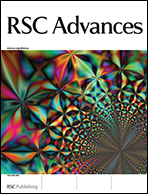Synthesis, crystal structure and bio-macromolecular interaction studies of pyridine-based thiosemicarbazone and its Ni(ii) and Cu(ii) complexes†
Abstract
A new pyridine-based heterocyclic thiosemicarbazone ligand and its Ni(II) and Cu(II) complexes have been synthesized and characterized by structural, analytical and spectral methods. The mono-deprotonated anionic form of the ligand coordinates via NNS donor atoms to yield an octahedral Ni(II) complex and distorted square planar Cu(II) complex. UV-visible and fluorescence-based spectroscopic techniques revealed that both metal complexes interact with double stranded DNA via intercalation. A comparative assessment indicated that the Ni(II) complex displayed superior DNA binding. The interaction of these compounds with bovine serum albumin (BSA) suggested that the ligand and its Cu(II) complex quenched the intrinsic fluorescence of BSA in a static quenching process, whereas for the Ni(II) complex, fluorescence quenching of BSA was a combination of both static and collision/dynamic quenching processes. The quenching of the fluorescence of BSA is owing to energy transfer from the tryptophan residues of BSA to the compounds bound to BSA. Cytotoxicity tests based on the standard MTT assay revealed that the Cu(II) complex displayed prominent anti-proliferative activity against HeLa cells.


 Please wait while we load your content...
Please wait while we load your content...